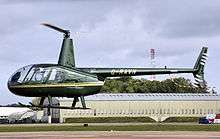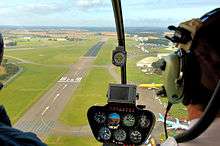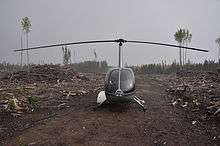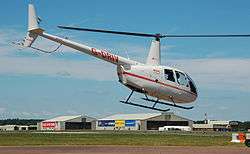Robinson R44
| R44 | |
|---|---|
 | |
| Role | Light utility and trainer helicopter |
| Manufacturer | Robinson Helicopter Company |
| Designer | Frank D. Robinson |
| First flight | 31 March 1990 |
| Introduction | 1993 |
| Status | in production |
| Produced | 5610 (2012)[1] |
| Unit cost |
from US$425,000 (2011) |
| Developed from | Robinson R22 |
| Developed into | Robinson R66 |
The Robinson R44 is a four-seat light helicopter produced by Robinson Helicopter Company since 1992. Based on the company's two-seat Robinson R22, the R44 features hydraulically assisted flight controls. The R44 was first flown on 31 March 1990 and received FAA certification in December 1992, with the first delivery in February 1993.
Design and development
The R44 is a single-engined helicopter with a semi-rigid two-bladed main rotor, a two-bladed tail rotor and a skid landing gear. It has an enclosed cabin with two rows of side-by-side seating for a pilot and three passengers. Tail rotor direction of rotation on the R44 is reversed compared to the R22 for improved yaw control authority. On the R44 the advancing blade is on the bottom.
Designed during the 1980s by Frank Robinson and his staff of engineers, the R44 first flew on 31 March 1990. The R44 Astro was awarded an FAA Type Certificate in December 1992, with the first deliveries taking place in January 1993. In January 2000, Robinson introduced the Raven with hydraulically assisted controls[2] and adjustable pedals. In July 2002, Robinson introduced the Raven II featuring a more powerful, fuel-injected engine and wider blades, allowing a higher gross weight and improved altitude performance.
Robinson produced 186 R44s in 2014.[3]
During November 2015 Robinson announced the Cadet, a Raven I with a cargo area instead of the two back seats, a slightly less powerful engine and a more efficient muffler.[4]
Operators




Civilian operators
The aircraft is operated by many private individuals, companies and flying clubs.
In 1997, a Robinson R44 was piloted by Jennifer Murray for the first helicopter circumnavigation of the world by a woman, covering a distance of 36,000 miles in 97 days.[5][6] As of 2014, an R44 holds the piston speed record of 227 km/h.[7]
Police operators
Military operators
- Royal Jordanian Air Force (eight on order)[14]
Accidents and incidents
The R44 was found to be prone to post-accident fires due to damage to the aluminum fuel tanks, allowing fuel to leak out. In 2009, the company began installing bladder-type fuel tanks in all new R44 helicopters. It also issued Service Bulletin SB-78 on 20 December 2010, requiring R44 helicopters with all-aluminum fuel tanks to be retrofitted with bladder-type tanks to "improve the R44's fuel system's resistance to a post-accident fuel leak." The company recommended that the change should be done as soon as practical, but no later than 31 December 2014. The compliance date was later moved to 30 April 2013.[16]
An accident investigation by the Australian Transport Safety Bureau (ATSB) in March 2013 found, after analyzing historical data, that a significantly higher proportion of R44 aircraft (12%) caught fire after crashing, compared to accidents involving other types of piston-engine helicopters (7%).[17] Preliminary analysis by the ATSB of the NTSB's accident database found a similar statistic, with 15% of accidents in the US involving R44 helicopters having post-crash fires.[17]

Although the data did not consider which type of fuel tanks were fitted, the report mentioned four fatal accidents to the R44 fitted with bladder-type tanks, but as far as they knew, did not involve a post-accident fire. The ATSB recommended that the Australian Civil Aviation Safety Authority (CASA) take further action to urge R44 owners to fit bladder-type tanks.[18] The FAA, the governing body in the country of manufacture whose directives would normally be followed in other countries like Australia, had not mandated the retrofit; CASA therefore issued Australian-specific airworthiness directive AD/R44/23, grounding R44 aircraft on 30 April 2013 that had not yet been upgraded.[19]
On 19 February 2015, the New Zealand Civil Aviation Authority issued an Airworthiness Directive grounding 80 of the country's R44 helicopters after two people were killed in an accident traced to a particular type of main rotor blade, the P/N C016-7 or Dash 7, which a preliminary investigation determined had failed in flight - the second failure or partial-failure in two months. This was the largest-scale grounding of any aircraft in New Zealand's history. The CAA determined through laboratory tests that the rotor blade had failed due to overload during the crash and was not the cause of the accident and the fleet was ungrounded on 24 February 2015. The CAA left the Airworthiness Directive requiring repetitive inspections in place, however. Director of Civil Aviation, Graeme Harris stated, "we don’t want to see any complacency amongst operators as there is still a concern with these blades and we are waiting on test results from the USA before we review the Airworthiness notice."[20] Following the grounding in New Zealand, Australia's Civil Aviation Safety Authority (CASA) also grounded R44 Helicopters with the same rotor blades.[21][22][23]
Specifications (R44 Raven II)
Data from Robinson R44 Raven II Pilot's Operating Handbook and FAA approved rotorcraft flight manual, dated 13 June 2005.
General characteristics
- Crew: one or two pilots
- Capacity: four, including pilot
- Payload: 748 lb (340 kg)
- Length: 38 ft 3 in (11.65 m)
- Rotor diameter: 33 ft (10.1 m)
- Tail rotor diameter: 4 ft 10 in (1.5 m)
- Height: 10 ft 9 in (3.3 m)
- Empty weight: 1,450 lb (657.7 kg)
- Loaded weight: 2,500 lb (1,134 kg)
- Powerplant: 1 × Lycoming IO-540-AE1A5 6 cylinder, flat engine with fuel injection, 245 bhp (183 kW)
- Fuel: 100 low lead (100LL) fuel or 100/130.
- Main tank capacity: 31.6 US gallons (120 liters)
- Main tank usable fuel: 30.6 US gallons (116 liters)
- Auxiliary tank capacity: 18.5 US gallons (70 liters)
- Auxiliary tank usable fuel: 18.3 US gallons (69 liters)
Performance
- Maximum speed: 130 kn (240 km/h; 150 mph)
- Cruise speed: 110 kn (200 km/h; 130 mph)
- Range: 300 nmi (560 km; 350 mi)
- Fuel consumption: 15 US gallons (57 l) of Avgas per hour[24] Not given in Pilot's Handbook.[2]
- Altitude restrictions: 14,000 ft (4,300 m) density altitude or 9,000 ft (2,700 m) above ground level in order to be able to reach ground within 5 minutes in case of fire.
See also
- Related development
- Aircraft of comparable role, configuration and era
Footnotes
- ↑ Robinson-Journal-2013.
- 1 2 Greenspun, Philip. "Robinson R44 Raven I – owner's review" July 2014. Accessed: 20 September 2014.
- ↑ Head, Elan (2015). "Expanded options". Vertical Magazine, Heli-Expo news. pp. 64–66. Retrieved 11 April 2015.
- ↑ "Robinson introduces the two-place R44 Cadet" (PDF). Robinson Helicopter. Retrieved 19 November 2015.
- ↑ "FAI Record ID #6703 – Speed around the world, eastbound females. Class E-1 (Helicopters), piston" Fédération Aéronautique Internationale (FAI). Retrieved: 20 September 2014.
- ↑ "Around the world in 99 days"
- ↑ "Speed over a straight 15/25 km course – Class E-1 (Helicopters), piston". Fédération Aéronautique Internationale (FAI). Note search under E-1 Helicopters and "Speed over a straight 15/25 km course". Accessed: 26 April 2014.
- ↑ http://www.wood.ru/ru/lonewsid-26039.html
- ↑ GMA-News.
- ↑ AirspaceTechnology.
- ↑ "Down one search-and-rescue helicopter, Alaska State Troopers reorganize". Alaska Dispatch News. Retrieved December 6, 2015.
- 1 2 3 Flightglobal Insight.
- ↑ airliners.net.
- ↑ "HeliHub Royal Jordanian Air Force buys eight R44s to replace MD500s". helihub.com. Retrieved 23 February 2015.
- ↑ RHC Media.
- ↑ SB-78B.
- 1 2 ATSB-2013, p. 7.
- ↑ ATSB-2013, p. 12.
- ↑ CASA-2013.
- ↑ Kenny, Katie; Mann, Brittany (21 February 2015). "Chopper ban after deaths unprecedented". Fairfax New Zealand. Retrieved 22 February 2015.
- ↑ Ward, Nicholas (21 February 2015). "EMERGENCY AIRWORTHINESS DIRECTIVE - AD/R44/24 Prohibition of Flight - C016-7 Main Rotor Blades" (PDF). Civil Aviation Safety Authority. Retrieved 23 February 2015.
- ↑ Niles, Russ (21 February 2015). "Australia, New Zealand Ground Some R-44s". AVweb. Retrieved 23 February 2015.
- ↑ Civil Aviation Authority of New Zealand (24 February 2015). "CAA lifts flight ban on Helicopters" (PDF). Retrieved 2 June 2015.
- ↑ Larson, George C. Robinson: Ready for the Rebound Aviation Week, 2 March 2011. Accessed: 6 March 2011. Paywall Library
References
- "Production Tops 500 in 2012" (pdf). Robinson News. 19 (1). Winter 2013.
- "Flying prince Philip again aggravates inhabitants of Brussels". Het Belang Van Limburg. 7 April 2011. Retrieved 11 August 2011.
- "PNP gets 3 Raven choppers for anti-crime operations". GMA News. Retrieved 11 February 2010.
- Collision with Terrain Involving Robinson R44 Helicopter, VH-HWQ (pdf) (Report). Australian Transport Safety Bureau. 21 March 2013. Retrieved 19 September 2013.
- "R44 service bulletin sb-78b" (PDF). Robinson Helicopter Company. 28 September 2012. Retrieved 7 July 2013.
- %5b%5bCategory:All articles with dead external links%5d%5d%5b%5bCategory:Articles with dead external links from September 2013%5d%5d "AirspaceTechnology R44" Check
|url=value (help). AirSpaceTechnology. 2011. Retrieved 1 August 2013. - "Lebanese Army Takes Delivery of Two More Robinsons" (pdf). RHC media. Retrieved 10 January 2013.
- "World Air Forces 2013" (pdf). Flightglobal Insight. 2013. Retrieved 17 March 2013.
- "Robinson R-44 Clipper". airliners.net. Retrieved 10 January 2013.
- "Airworthiness Directive AD/R44/23" (pdf) (Press release). CASA. 29 April 2013. Retrieved 25 September 2013.
External links
| Wikimedia Commons has media related to Robinson R44. |
- Official website
- European Aviation Safety Agency – Type Certificate Data Sheet – R44 and R44 II pdf
- accident database at Griffin Helicopters